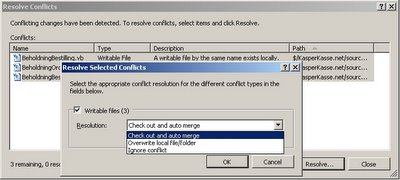I should have know better, copying controls was a recipy for immediate disaster in the VS2005 betas; you could be sure that the Visual Studio designer would fail when you later on re-opened the user-control. The same applied to renaming a control after modifying some of its properties. These problems have been fixed in the release version of VS, although opening a form still randomly causes the cursor to go into a blink frenzy for quite some time while re-syncing with the .Designer file.
Copying those combos kept some of the data binding properties (ValueMember, DisplayMember), but did not copy the binding sources (more on this below). I added the object binding sources in the 'Data Sources' explorer, and after some refreshing of the project data sources (error II), object binding seemed to work properly.
Today, I added another object binding source to the 'Data Sources' explorer of the user-control. If I then tried to use the DataSource property at design-time, I got this error:
Object reference not set to an instance of an object
Setting the data binding at run-time work fine. So does copying the original data source binding code from the hidden .Designer file, it even shows correctly in the control properties explorer, but cannot be changed due to the above error. But this is not how I want to do it, I wanted design-time binding to work. Any attempt to modify data binding on any controls in the form would cause the design-time error.
In an attempt to fix the binding problems, I used an old trick when working with software and computers; I restarted Visual Studio, opened the solution and cleaned it. Then I clicked the DataSource property of my failing combo. Now I got this error, which anyone who have parsed XML will recognize:
Root element is missing
After Visual Studio had shown this puzzling error (as usual no intelligble info provided in the message), all design-time data binding worked properly again and the combos were filled at run-time. Oh joy! . . . But the object binding source that I had added lastly, was gone from the 'Data Sources' explorer. As long as the design-time binding kind of worked again, I could live with that.
I suspected that there was a problem with one XML files in the solution and checked the various .RESX files and some other files with XML content, but I was not been able to find any error. When I had just about given up, I noticed that the three listed data sources in the 'Data Sources' explorer also happened to be the three first .datasource files in the
I excluded the empty file from the project, reloaded the solution, and then all the project data sources were listed in the 'Data Sources' explorer. Design-time binding now works as expected again. Oh, even more joy!
I am still sceptical to copying object bound controls from one WinForms user-control to another. The VS designer might punish you. Maybe I am just being paraniod.

